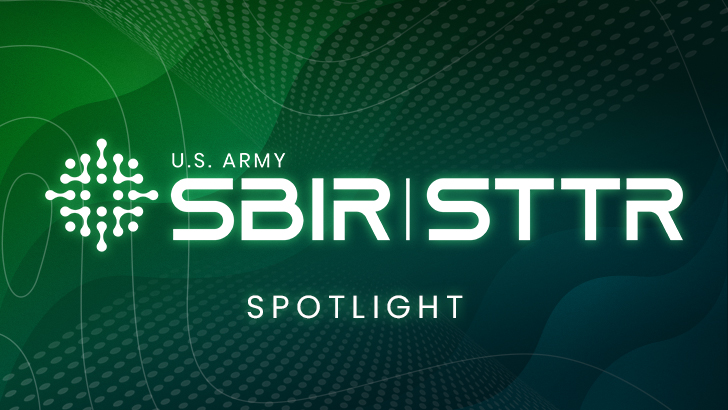

By Anna Volkwine and Hawa Jack, Army Innovation Programs
Pratt Miller Defense’s Trackless Moving Targets program is revolutionizing Army range training with support from the U.S. Army Small Business Innovation Research and Small Business Technology Transfer Program. Army SBIR funding served as a catalyst for the technology’s development, creating a path for transition that will see the TMT training system implemented at Army and National Guard training centers beginning in summer 2025.
In 2012, Pratt Miller partnered with the Army via a SBIR Phase I contract to modernize live-fire marksmanship training technology. The innovative TMT training system, available in infantry (TMT-I) and vehicle (TMT-V) representations, combines highly mobile platforms with GPS-based path-following and advanced hit-detection systems. The system simulates reactive behaviors and precisely scores hits to create a realistic training environment.
Transition award improves marksmanship training
The TMT training system augments or replaces the stationary and predictable target systems in current use by the Army and enables Soldiers to train accurately and effectively for combat missions. The Army’s existing marksmanship target systems rely on stationary pop-up targets, including stationary infantry targets, stationary armor targets and moving targets that support linear-only movement. The outdated targets move at a constant velocity, presenting only a 2D target representation that includes moving infantry targets and moving armor targets. In contrast, the TMT system is dynamic, portable and cost-effective.
Pratt Miller prioritized Soldier safety, integration with the Army’s range software, and long-term durability during the development of the training system. In 2013, Pratt Miller received a follow-on Army SBIR Phase II contract award to integrate the TMT system into the Army’s Targetry Range Automated Control and Recording II software, which combined mobile armored platforms with GPS path-following technology and zone-based hit detection. The Army SBIR|STTR Program awarded a second Phase II contract to the company in 2016 to facilitate the addition of advanced capabilities, including features that allow the platform to make emergency stops without user intervention. Pratt Miller used the contract awards for live-fire training, leading to a $25.7 million Phase III full-rate production contract in September 2024.
Through the company’s collaboration with the Army SBIR|STTR Program, Pratt Miller developed a comprehensive training system that advances Soldier preparedness. Operating throughout the entire range safety zone, the system enables 360-degree engagement with realistic reactive behaviors and variable speeds, dramatically increasing training value and effectiveness.
Pratt Miller’s system can also be Soldier-operated and maintained. By eliminating the need for external support, the enhanced training system significantly reduces life cycle costs and increases operational flexibility.
“The Army SBIR|STTR Program is a great conduit for developing and applying cutting-edge technologies, which we can then also apply to other Department of Defense programs to further help the warfighter,” said Jim Fontaine, executive director of robotics at Pratt Miller Defense.
Army targets nine installations for initial fielding
The company’s transition award in 2024 with Program Executive Office Simulation, Training and Instrumentation facilitated the testing and deployment of the TMT technology. This includes the production and initial fielding support at Fort Bragg, North Carolina; Fort Cavazos, Texas; Fort Campbell, Kentucky; Fort Carson, Colorado; Joint Base Lewis McCord, Washington; Fort Drum, New York; Fort Huachuca, Arizona; Fort Barfoot, Virginia; and Fort Johnson, Louisiana. Implementation will start in summer 2025 and finish by late 2026. The Army has plans to field additional ranges between 2027 and 2029.
“At Pratt Miller, we are built on a foundation of innovation and technology, principles that align closely with the SBIR initiative. Seeing TMTs in the hands of the warfighter demonstrates our commitment to transforming what’s possible, while developing cutting-edge technology that challenges the status quo,” said Sandy McKinnon, communications director at Pratt Miller Defense. “This program is a true reflection of our core values and underscores the importance of the SBIR|STTR Program in driving that transformation.”

About the Army SBIR|STTR Program
Army SBIR continuously releases funding opportunities, including Phase I funding for commercially viable, feasible, and technically sound solutions. Firms with mature technologies meeting Phase I requirements can advance to Phase II or go directly to Direct to Phase II contracts. Throughout the process, technical, acquisition, and operational Army experts guide businesses to align their innovations with the Army’s critical needs.
Army STTR integrates small businesses in the Army innovation ecosystem by partnering them with universities, federally funded research and development centers, or qualified non-profit research institutions, with small businesses as the prime contractors. Small businesses must act as prime contractors, performing at least 40 percent of the work while research partners perform at least 30 percent.
ASA(ALT) leverages innovative technologies to give Soldiers a decisive advantage in any environment by developing, acquiring, fielding, and sustaining the world’s finest equipment and services. For more information, visit the ASA(ALT) web page and follow @ArmyASAALT.
Stay Updated
Subscribe to email updates or check back on the Army SBIR|STTR website. Follow us on Facebook, X (formerly Twitter) and LinkedIn. For inquiries, contact us at the Army SBIR|STTR mailbox and the Army xTech mailbox.
